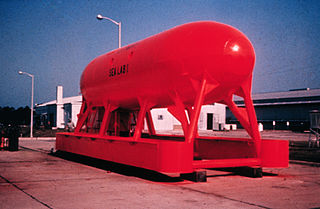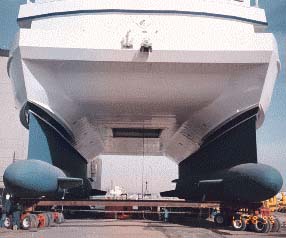
Deep Submergence Vessel NR-1 was a unique United States Navy (USN) nuclear-powered ocean engineering and research submarine, built by the Electric Boat Division of General Dynamics at Groton, Connecticut. NR-1 was launched on 25 January 1969, completed initial sea trials 19 August 1969, and was home-ported at Naval Submarine Base New London. NR-1 was the smallest nuclear submarine ever put into operation. The vessel was casually known as "Nerwin" and was never officially named or commissioned. The U.S. Navy is allocated a specific number of warships by the U.S. Congress, but Admiral Hyman Rickover avoided using one of those allocations for the construction of NR-1 in order to circumvent the oversight that a warship receives from various bureaus.

Splashdown is the method of landing a spacecraft in a body of water, usually by parachute. The method has been used primarily by American crewed capsules including NASA’s Mercury, Gemini, Apollo and Orion along with the private SpaceX Dragon. It is also possible for the Russian Soyuz and the Chinese Shenzhou crewed capsules to land in water, though this is only a contingency.

USS Dolphin (AGSS-555) was a United States Navy diesel-electric deep-diving research and development submarine. She was commissioned in 1968 and decommissioned in 2007. Her 38-year career was the longest in history for a US Navy submarine to that point. She was the Navy's last operational conventionally powered submarine.

Malcolm Scott Carpenter was an American naval officer and aviator, test pilot, aeronautical engineer, astronaut and aquanaut. He was one of the Mercury Seven astronauts selected for NASA's Project Mercury in April 1959. Carpenter was the second American to orbit the Earth and the fourth American in space, after Alan Shepard, Gus Grissom and Glenn.

SEALAB I, II, and III were experimental underwater habitats developed and deployed by the United States Navy during the 1960s to prove the viability of saturation diving and humans living in isolation for extended periods of time. The knowledge gained from the SEALAB expeditions helped advance the science of deep sea diving and rescue, and contributed to the understanding of the psychological and physiological strains humans can endure.

Underwater habitats are underwater structures in which people can live for extended periods and carry out most of the basic human functions of a 24-hour day, such as working, resting, eating, attending to personal hygiene, and sleeping. In this context, 'habitat' is generally used in a narrow sense to mean the interior and immediate exterior of the structure and its fixtures, but not its surrounding marine environment. Most early underwater habitats lacked regenerative systems for air, water, food, electricity, and other resources. However, some underwater habitats allow for these resources to be delivered using pipes, or generated within the habitat, rather than manually delivered.
Operation Deep Freeze is codename for a series of United States missions to Antarctica, beginning with "Operation Deep Freeze I" in 1955–56, followed by "Operation Deep Freeze II", "Operation Deep Freeze III", and so on.. Given the continuing and constant US presence in Antarctica since that date, "Operation Deep Freeze" has come to be used as a general term for US operations in that continent, and in particular for the regular missions to resupply US Antarctic bases, coordinated by the United States military. Task Force 199 was involved.
John Piña Craven was an American scientist who was known for his involvement with Bayesian search theory and the recovery of lost objects at sea. He was Chief Scientist of the Special Projects Office of the United States Navy.

The Scorpio is a brand of underwater submersible Remotely Operated Vehicle (ROV) manufactured by Perry Tritech used by sub-sea industries such as the oil industry for general operations, and by the Royal Navy and the United States Navy for submarine rescue services. Originally developed by AMETEK Straza of El Cajon, California, they were subsequently developed by Perry Tritech. Although the design of the original Scorpio is over several decades old, it forms the basis for a current generation of Scorpio-branded ROVs. Scorpio ROVs are named in a sequence following the order of manufacture, such as "Scorpio 17" or "Scorpio 45" which refer to specific ROVs.

A United States Navy diver may be a restricted fleet line officer, Civil Engineer Corps (CEC) officer, Medical Corps officer, an Unrestricted Line Officer who is qualified in Explosive Ordnance Disposal (EOD) Warfare (1140) or an enlisted who is qualified in underwater diving and salvage. Navy divers serve with fleet diving detachments and in research and development. Some of the mission areas of the Navy diver include: marine salvage, harbor clearance, underwater ship husbandry and repair, submarine rescue, saturation diving, experimental diving, underwater construction and welding, as well as serving as technical experts to the Navy SEALs, Marine Corps, and Navy EOD diving commands.

A moon pool is an equipment deployment and retrieval feature used by marine drilling platforms, drillships, diving support vessels, fishing vessels, marine research and underwater exploration or research vessels, and underwater habitats. It is also known as a wet porch. It is an opening found in the floor or base of the hull, platform, or chamber giving access to the water below. Because of its stable location, it safely allows technicians or researchers to lower tools and instruments into the sea.
The High Performance Wireless Research and Education Network (HPWREN) is a network research program, funded by the National Science Foundation. The program includes the creation, demonstration, and evaluation of a non-commercial, prototype, high-performance, wide-area, wireless network in its Southern California service area.
Founded in 1981, MTN Satellite Communications (MTN), formerly known as Maritime Telecommunications Network, was a privately held VSAT satellite service provider headquartered in Miramar, Florida, USA. MTN provided connectivity services to major cruise lines, including Carnival Corporation, Royal Caribbean International, Norwegian Cruise Lines and well as luxury yachts, oil rigs, government and military vessels, and commercial vessels. MTN was acquired by Emerging Markets Communications in 2015.
A number of suborbital spaceflights were conducted during 2008. These consist mostly of sounding rocket missions and missile tests, and include other flights such as an ASAT firing. Between the start of the year and 16 July, at least 43 publicly announced suborbital spaceflights were conducted, the first of them on 11 January.

MV Carolyn Chouest is a chartered support ship for the United States Navy that was originally assigned to the Special Missions Program to support NR-1, the deep submergence craft. She towed NR-1 between work areas, served as a floating supply warehouse and provided quarters for extra crew until the NR-1 was removed from service in 2008.

Captain George Foote Bond was a United States Navy physician who was known as a leader in the field of undersea and hyperbaric medicine and the "Father of Saturation Diving".

Berry Louis Cannon was an American aquanaut who served on the SEALAB II and III projects of the U.S. Navy. Cannon died of carbon dioxide poisoning while attempting to repair SEALAB III. It was later found that his diving rig's baralyme canister, which should have absorbed the carbon dioxide Cannon exhaled, was empty.
Joseph Beverly MacInnis is a Canadian physician, author, and diver. In 1974, MacInnis was the first scientist to dive in the near-freezing waters beneath the North Pole. In 1976 he became a member of the Order of Canada.

John Morgan Wells was a marine biologist, and physiologist involved in the development of decompression systems for deep diving, and the use of nitrox as a breathing gas for diving. He is known for developing the widely used NOAA Nitrox I and II mixtures and their decompression tables in the late 1970s, the deep diving mixture of oxygen, helium, and nitrogen known as NOAA Trimix I, for research in undersea habitats, where divers live and work under pressure for extended periods, and for training diving physicians and medical technicians in hyperbaric medicine.

Robert August Barth was a United States Navy Chief Quartermaster, pioneering aquanaut and professional diver. He was the only diver to participate in all U.S. Navy SEALAB missions led by George F. Bond. Barth is considered to be the father of the Rolex Sea Dweller. In 1967, he developed the idea for the helium release valve which was patented by Rolex on November 6, 1967.













